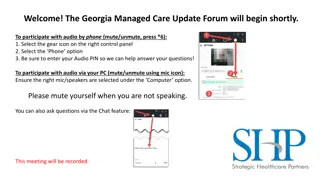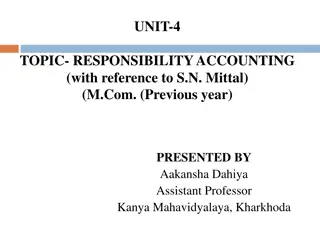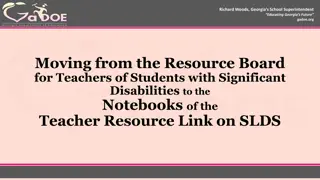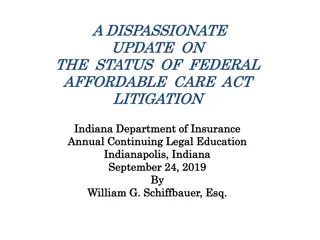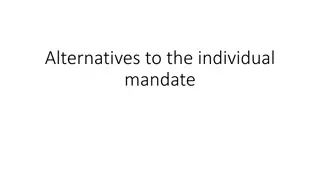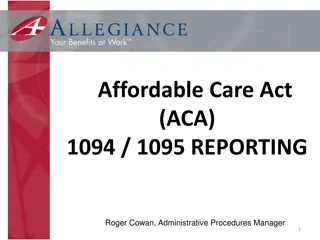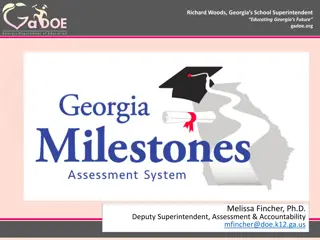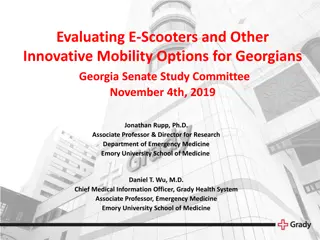Shared Responsibility Mandate for Affordable Care Act in Georgia
Ensure compliance with ACA regulations in Georgia regarding employer-provided health coverage, with details on coverage requirements, affordability, penalties for non-compliance, and tracking methods.
Download Presentation

Please find below an Image/Link to download the presentation.
The content on the website is provided AS IS for your information and personal use only. It may not be sold, licensed, or shared on other websites without obtaining consent from the author.If you encounter any issues during the download, it is possible that the publisher has removed the file from their server.
You are allowed to download the files provided on this website for personal or commercial use, subject to the condition that they are used lawfully. All files are the property of their respective owners.
The content on the website is provided AS IS for your information and personal use only. It may not be sold, licensed, or shared on other websites without obtaining consent from the author.
E N D
Presentation Transcript
1 The Affordable Care Act (ACA) Shared Responsibility Mandate Creating A More Educated Georgia
2 Shared Responsibility Mandate If employer offers coverage, must be offered to 95% of full- time employees Must be Affordable Must meet Minimum Value Standards Use Safe Harbor guidelines to determine track time of Creating A More Educated Georgia
3 Coverage Defined as: 95% of full-time employees Full-time is defined as average of 30+ hours per week Includes employee s children to age 26 Spouses or domestic partners not required Must have the opportunity to enroll at least once per year Creating A More Educated Georgia
4 Affordability Affordable coverage is coverage that is 9.5% or less of household income Federal government offered 3- Safe Harbors to employers USG is using the Federal Poverty Line Safe Harbor: Must offer coverage with an employee premium that is 9.5% or below the Federal Poverty level 2014 Federal Poverty level is $11,680; 9.5% of $11,680 is $1,110 or a monthly premium of $92 USG High Deductible Health Plan monthly premium is $47 Under Safe Harbor, employee is not eligible for subsidy in the exchange market and USG would not be subject to penalties Creating A More Educated Georgia
5 Minimum Value 60% minimum plan value based on ACA rules definition of essential health benefits Healthcare Plan s actuary has confirmed all USG Healthcare plans meet Minimum Value coverage as defined by ACA Creating A More Educated Georgia
6 Penalties for not meeting Shared Responsibility requirements If don t meet coverage requirements: $2,000 times total number of FTEs not counting first 30 FTEs if don t meet coverage requirements If don t meet affordability requirements: Up to $3,000 annually for each FTE receiving income based assistance for health insurance exchange coverage Each USG institution s management is accountable and responsible for achieving and maintaining compliance with the requirements under the Affordable Care Act Each USG institution will be held financial accountable for non-compliance Creating A More Educated Georgia
Tracking Time Worked - initiallyall employees not offered health insurance 7 Safe Harbor Tracking Method Look-back or measurement period (3-12 months), this is the period of time in which hours will be tracked for part-time employees; standard year after year After the measurement period, employers have the option to have an administrative period (up to 90 days); this period is used to determine eligibility and facilitate enrollment of any employees who meet eligibility Stability period period during which part-time employees who met eligibility may elect to participate in the healthcare plan (6-12 months) Hours worked for faculty must be calculated based on the academic year to determine eligibility unless they work during the summer Creating A More Educated Georgia
8 Example Tracking Periods Creating A More Educated Georgia
9 Reporting Employers are required to report their employer provided health coverage data to the Federal Government Creating A More Educated Georgia
10 Three Major Impacts 1. Must revise the USG Employee Category Policy and the definitions of employment and employee types Develop a Conversion Chart for Credit hours to hours worked for part-time faculty Set up tracking method to determine health benefits eligibility for part-time workers 2. 3. Creating A More Educated Georgia
11 Final Guidance Released February 10, 2014 Further Guidance on types of employees and hours of service 2015 Transition Tracking Period Provisions Transitional 6 month tracking period Must begin Creating A More Educated Georgia
12 Definitions from Guidance Seasonal Variable Hour Adjunct Faculty Rehired employees Creating A More Educated Georgia
13 Student Employees Creating A More Educated Georgia
Proposed Definition of Student Employees 14 Currently not exempt under ACA Proposed solution is to revise the Employee Category Policy: Students must work part-time except during the summer and holidays and may not exceed 1300 hours in any consecutive 12-month period International students and work study students must work no more than 20 hours per week Creating A More Educated Georgia
15 Next Steps Collect feedback from this group and from system-wide VPAAs, CBOs, and CHROs, last week of February or first week of March Finalize documents and distribute system wide mid-March Training sessions first two weeks in April Creating A More Educated Georgia
16 Send suggestions/comments to VPAA listserv Creating A More Educated Georgia








